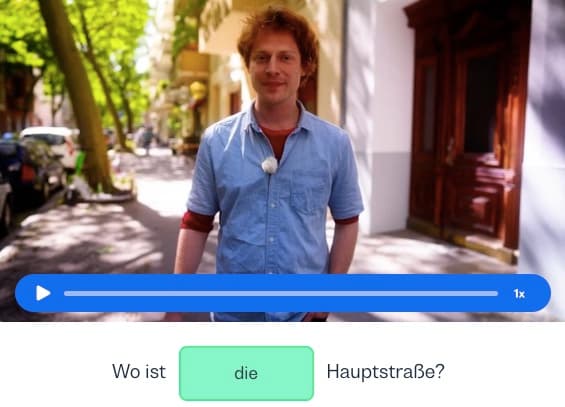I want to learn...
The German articles der, die and das (“the” in English) may be challenging, but fear not – they can be mastered. In this article, we’ll cover the basics of these articles in German, when to use them, which genders they match, and how we can make an educated guess as to what gender a particular noun has.
With a little practice, you’ll be using definite articles in German confidently in no time. Let’s start by looking at how these articles are used with different nouns according to the noun’s gender.
Der, die, das and noun gender
When dealing with articles, it is important to know that all nouns in German have a gender. They can either be masculine, feminine or neuter.
Definite articles in German have to match the gender of the noun, such as der Tisch (the table – masculine),die Schule (the school – feminine) and das Auto (the car – neuter).
German definite articles (der, die, das)
| Noun Gender | German | English |
|---|---|---|
| Masculine | der Mann | the man |
| Feminine | die Frau | the woman |
| Neuter | das Kind | the child |
Try to memorize the article for each new word you learn. This will help you remember which article to use each time, and to speak more naturally.
Using der, die and das with plural nouns
Now that you know the three articles used for nouns in their singular form, let’s look at how these articles change to match a noun’s plural form. Don’t worry, this one is a little easier. No matter if the noun is masculine, feminine or neuter, in the plural form we always use die (the).
Let’s look at a few examples:
Masculine: der Mann (singular) – die Männer (plural)
Feminine: die Frau (singular) – die Frauen (plural)
Neuter: das Kind (singular) – die Kinder (plural)
Next, we’ll take a look at some tips to help you remember when to use these articles.
When to use der, die and das in German
Although choosing the correct definite article in German may seem tricky at first, the German language has certain rules that can help you know which one to use.
1. Check the noun’s meaning
If the noun is animate, its grammatical gender tends to be the same as its actual gender: Male persons are usually masculine, female persons are usually feminine and young persons and baby animals are often neuter.
Here are some examples:
der Bruder/die Schwester (brother/sister)
der Opa/die Oma (grandad/grandma)
das Kind/das Baby (child/baby)
der Kater/die Katze (male cat/female cat)
das Lamm (lamb)
Of course, as with all languages, there are exceptions to the rules. The word das Mädchen (the girl) is neuter from a grammatical point of view; however, it refers to a female person. And referring to animals is also complicated, as you can use die Katze as a generic word for all types of cats, regardless of their sex.
An easy way to identify whether nouns that refer to people are masculine or feminine is by looking at their endings.
For instance, we add -in to nouns that refer to females. This rule especially applies to job titles such as Lehrer (male teacher) /Lehrerin (female teacher) orKoch (male cook) /Köchin (female cook), and also when we are characterizing or labeling a person in some way:Freund (male friend) /Freundin (female friend) or Lügner (male liar) /Lügnerin (female liar).
Exceptions: Some of the persons ending on -e can be masculine or feminine, e.g. "der Angestellte" (male employee), "die Angestellte" (female employee).
2. Learn noun categories
As we touched on above, German nouns belong to specific gender categories. For instance, seasons, directions on the compass, months and days of the week are all masculine.
Most weather words and alcoholic beverages also tend to be masculine, with the exception of das Bier(beer), which is neuter in German. Cars are masculine when you use their brand name.
Der Mai (May)
Der Sommer (the summer)
Der Montag (Monday)
Der Norden (the north)
Der Sturm (the storm)
Der Whisky (the whisky)
Der Audi (the Audi)
Feminine categories include tree and flower species and most fruits, as well as the brand names or proper names of motorbikes, ships and airplanes.
Die Zitrone (the lemon)
Die Rose (the rose)
Die Tanne (the fir)
Die Kawasaki (the Kawasaki)
Die Titanic (the Titanic)
Nouns are neuter when they refer to the names of restaurants, cafes, hotels and movie theaters, e.g., das Ritz ( hotel), das P1 (club), das Alex (cafe).
Also good to know: If a verb is used as a noun, that noun is neuter: leben/das Leben (to live/ life).
Charts for picking der, die, or das according to noun endings
You can increase your odds of getting the gender right by memorizing the endings that typically align with either masculine, feminine or neuter nouns.
Masculine nouns: Der
| Noun ending | Example | English |
|---|---|---|
| -us | der Bus | the bus |
| -ling | der Frühling | the spring |
| -ant | der Elefant | the elephant |
| -ent | der Student | the student |
| -ast | der Gast | the guest |
| -er | der Käfer | the bug |
| -en | der Regen | the rain |
| -ig | der Honig | the honey |
| -or | der Humor | the humor |
As you can see, you don’t necessarily have to know the meaning of the German word right away, simply memorizing the endings will help you a lot.
Die – Feminine article
When you start learning German, you will soon notice that most common German nouns ending with -e are feminine, e.g., die Sonne (the sun), die Lampe (the lamp), die Tasche (the bag). Note that there are also quite a few exceptions to this rule, such as: der Name (the name), das Auge (the eye), der Käse (cheese).
Here are some common endings of feminine nouns:
Feminine nouns: Die
| Noun ending | Example | English |
|---|---|---|
| -ie | die Philosophie | the philosophy |
| -ung | die Wohnung | the flat |
| -tät | die Nationalität | the nationality |
| -tion/sion | die Information | the information |
| -schaft | die Mannschaft | the team |
| -keit/heit | die Krankheit | the illness |
| -enz/anz | die Eleganz | the elegance |
| -ei | die Bäckerei | the bakery |
| -ur | die Figur | the figure |
| -in | die Bäckerin | the (female) baker |
Das – Neuter article
And last, but not least, the next chart is for endings that typically indicate that the noun is neuter.
Neuter nouns: Das
| Noun ending | Example | English |
|---|---|---|
| -lein | das Büchlein | the small Book |
| -chen | das Mädchen | the girl |
| -um | das Datum | the date |
| -nis | das Ergebnis | the result |
| -tum | das Eigentum | the property |
Good to know: Most German nouns ending with -ent are masculine. However, there are a few cases with a neuter ending, e.g., das Prozent (the percentage) and das Talent (the talent). Event can even be both, masculine and neuter: der Event or das Event (the event).
While -or is mainly a masculine ending, there is one exception: das Labor (the laboratory).
Der, die and das : Recap
While there are ways to guess the gender, and therefore the correct articles of nouns you haven’t learned yet, the best way is still to learn every new noun together with its article.
Don’t stress too much while you’re learning these articles; even if you use the wrong one at times, most German speakers will still understand what you mean.
Follow your instinct as you continue your learning journey. Once you are more experienced at using these German articles, you will start getting things right automatically. And remember that it's OK to make mistakes.
Picking the correct definite article according to a noun’s gender is one of the more challenging parts of the German language for any skill level or proficiency, but you’re headed in the right direction. With a little practice, you’ll be using der, die and das comfortably in no time.
Newlanguages


